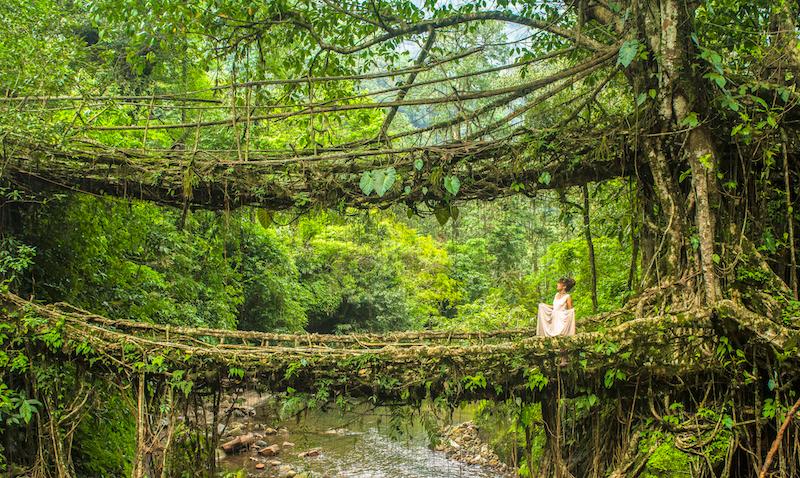The term "Double Decker" often brings to mind the iconic buses of London or multi-layered sandwiches. However, in the context of Meghalaya, India, it refers to a remarkable natural phenomenon—the Double Decker Root Bridge. This extraordinary living bridge, crafted by the Khasi tribe, is not only a testament to human ingenuity but also a stunning example of sustainable architecture. In this article, we’ll explore the Double Decker Root Bridge in detail, including its history, significance, how to visit, and the breathtaking experiences that await you.
What is the Double Decker Root Bridge?
The Double Decker Root Bridge is a living bridge located in the village of Nongriat, near Cherrapunji, one of the wettest places on Earth. This impressive structure is formed from the roots of the rubber tree (Ficus elastica), which are trained and manipulated by local tribespeople to grow across rivers and streams.
The "Double Decker" designation comes from its two levels, which allow pedestrians to cross the river effortlessly while navigating the steep terrain of the region. Unlike traditional bridges made of concrete or steel, this bridge is alive, growing and changing over time, making it a unique feature of the Khasi landscape.
The Cultural and Historical Significance
A Heritage of Craftsmanship
The creation of living root bridges dates back centuries, showcasing the traditional knowledge and skills of the Khasi people. Unlike conventional structures, these bridges are made without harming the trees, highlighting a profound respect for nature. The process of building a root bridge is labor-intensive and requires years of patience, often taking a decade or more for the roots to mature into a usable bridge.
A Symbol of Sustainability
In today’s world, where environmental sustainability is critical, the Double Decker Root Bridge serves as a powerful symbol of eco-friendly living. It emphasizes the importance of utilizing natural resources responsibly while creating functional structures. This method of construction minimizes carbon footprints and preserves the local ecosystem, making it an inspiring example for future architectural practices.
How to Reach the Double Decker Root Bridge
Getting There
Visiting the Double Decker Root Bridge is an adventure in itself. Here’s how to plan your trip:
- Travel to Cherrapunji: The nearest major city is Shillong, which is well connected by road and air. From Shillong, you can hire a taxi or take a bus to Cherrapunji, approximately 54 kilometers away. The journey takes about 2 to 3 hours, offering stunning views of the lush hills and valleys.
- Trek to Nongriat: Once in Cherrapunji, you will need to travel to Tyrna village, the starting point for the trek to Nongriat. Local taxis are available for this short ride. From Tyrna, you will embark on a trek that involves descending over 3,000 steps—an exhilarating experience that takes about 45 minutes to an hour, depending on your fitness level.
- Experience the Bridge: After reaching Nongriat, you will find the Double Decker Root Bridge nearby. Take your time to explore the area, capturing the beauty of this natural marvel.
Best Time to Visit
The ideal time to visit the Double Decker Root Bridge is during the winter months, from November to February. The weather is pleasant, with cool temperatures and clear skies, making trekking enjoyable. The monsoon season, from June to September, brings heavy rainfall, which can make the trek slippery and challenging.
What to Expect When Visiting
Breathtaking Scenery
The journey to the Double Decker Root Bridge is filled with breathtaking scenery. As you trek down, you will be surrounded by lush green forests, cascading waterfalls, and the sounds of nature. The vibrant flora and fauna add to the beauty, making the trek a memorable experience.
The Bridge Itself
Upon reaching the Double Decker Root Bridge, you’ll be amazed by its unique structure. The roots stretch across the river, forming a sturdy bridge that can support several people at a time. Walking on this living bridge is a surreal experience, connecting you to the natural world in a way that traditional structures cannot.
Nearby Attractions
After exploring the Double Decker, there are several nearby attractions worth visiting:
- Rainbow Falls: A short trek from Nongriat leads you to the stunning Rainbow Falls, known for its beautiful cascades and the rainbow that often appears in the mist. This is a perfect spot for photography and relaxation.
- Single Root Bridges: There are smaller, single-root bridges nearby that showcase the same incredible craftsmanship and offer additional opportunities for exploration.
- Local Culture: Take time to interact with the local Khasi people, learn about their traditions, and enjoy traditional meals. Their hospitality adds to the richness of your experience.
Tips for Your Visit
- Wear Comfortable Footwear: The trek involves many stairs and uneven terrain, so sturdy, comfortable shoes are essential.
- Stay Hydrated: Carry enough water to keep yourself hydrated during the trek.
- Respect the Environment: Remember to carry your trash back with you and respect the natural surroundings. Follow local guidelines to minimize your impact on the ecosystem.
- Hire a Local Guide: Consider hiring a local guide who can provide valuable insights into the history, culture, and ecology of the area.
- Capture the Moments: Bring a camera to capture the stunning views and the uniqueness of the Double Decker Root Bridge.
Conclusion
The Double Decker Root Bridge is not just a structure; it is a testament to the ingenuity of the Khasi people and the beauty of nature. Visiting this living bridge offers an opportunity to connect with the environment, learn about sustainable practices, and immerse yourself in the rich culture of Meghalaya.
Whether you’re an adventure seeker, a nature lover, or simply looking to explore unique destinations, the Double Decker Root Bridge is sure to leave a lasting impression. Plan your visit today and witness the magic of this natural wonder for yourself!





Comments